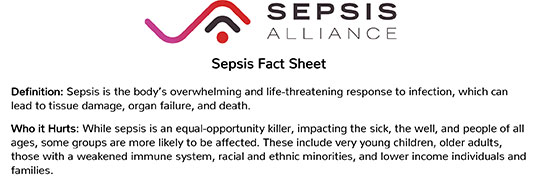Sepsis is a life-threatening emergency that happens when your body’s response to an infection damages vital organs and, often, causes death. In other words, it’s your body’s overactive and toxic response to an infection. Like strokes or heart attacks, sepsis is a medical emergency that requires rapid diagnosis and treatment. Sepsis can lead to severe sepsis and septic shock.
You may have heard the term “blood poisoning” used instead of sepsis. Blood poisoning is not an accurate description of sepsis. You can learn more about sepsis and blood poisoning here.
Your immune system usually works to fight any germs (bacteria, viruses, fungi, or parasites) to prevent infection. If an infection does occur, your immune system will try to fight it, although you may need help with medication such as antibiotics, antivirals, antifungals, and antiparasitics. However, for reasons researchers don’t understand, sometimes the immune system stops fighting the “invaders,” and begins to turn on itself. This is the start of sepsis.
Some people are at higher risk of developing sepsis because they are at higher risk of contracting an infection. These include the very young (infants), the very old, those with chronic illnesses, and those with a weakened or impaired immune system. People who are malnourished can also contract infections more easily.
Patients are diagnosed with sepsis when they develop a set of signs and symptoms related to sepsis. Sepsis is not diagnosed based on an infection itself. If you have more than one of the symptoms of sepsis, especially if there are signs of an infection or you fall into one of the higher risk groups, your doctor will likely suspect sepsis.
Sepsis progresses to severe sepsis when in addition to signs of sepsis, there are signs of organ dysfunction, such as difficulty breathing (problems with the lungs), low or no urine output (kidneys), abnormal liver tests (liver), and changes in mental status (brain).
Septic shock is the most severe stage and is diagnosed when your blood pressure drops to dangerous levels. These patients are treated in the ICU and many physicians call them the “sickest people in the hospital.”
Sepsis is the number 1 cost of hospitalization in the U.S. Costs for acute sepsis hospitalization and skilled nursing are estimated to be $62 billion annually. This is only a portion of all sepsis-related costs, since there are substantial additional costs after discharge for many.
The average cost per hospital stay for sepsis is double the average cost per stay across all other conditions. And, sepsis is the primary cause of readmission to the hospital, costing more than $3.5 billion each year.
Studies investigating survival and sepsis deaths have reported slightly different numbers, but it appears that on average, approximately 30% of patients diagnosed with severe sepsis do not survive. Up to 50% of survivors suffer from post-sepsis syndrome. Until a cure for sepsis is found, early detection and treatment is essential for survival and limiting disability for survivors.
Updated January 13, 2022.





























